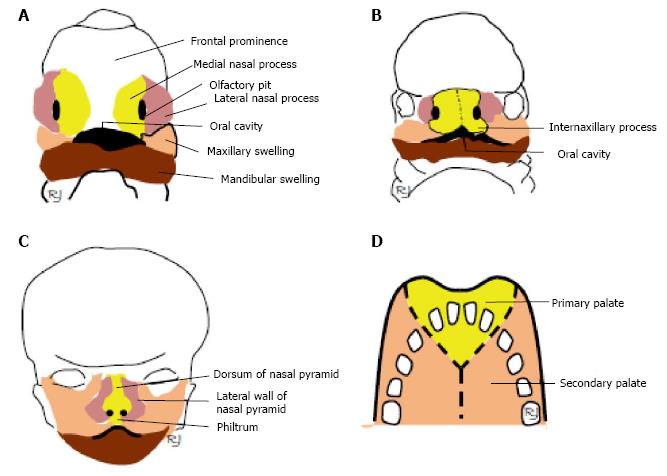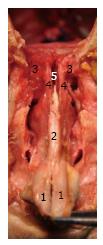Copyright
©The Author(s) 2016.
World J Otorhinolaryngol. May 28, 2016; 6(2): 33-40
Published online May 28, 2016. doi: 10.5319/wjo.v6.i2.33
Published online May 28, 2016. doi: 10.5319/wjo.v6.i2.33
Figure 1 Classic embryology of the nose.
A: Formation of the medial and lateral processes of the nose on the raised rim of the olfactory placodes; B: Formation of the intermaxillary process by fusion of the medial nasal processes; C: The intermaxillary process is seen as the primordium of the bridge and septum of the nose and the lateral nasal processes as the primordia of the lateral walls of the nasal pyramid; D: The intermaxillary process is seen as the primordium of the primary palate.
Figure 2 Evo-devo origin of the respiratory nose.
A: The palatal bones in the tetrapods (in: Internal naris; pm: Premaxilla; ma: Maxilla; vo: Vomer; pa: Palatine; pt: Pterygoid; ec: Ectopterygoid); B: Anatomy of the nasal septum in human (perpendicular plate of ethmoid and septal cartilage form the septum of the olfactory nose); C: Anatomy of the nasal lateral wall in human (ethmoid bone removed).
Figure 3 Anatomy of the olfactory nose.
The alar (1) and septolateral (2) cartilages are united to each other and to the ethmoidal skull base (3) by the olfactory fascia (4) (the perpendicular plate of the ethmoid (5) has been partially removed).
- Citation: Jankowski R, Márquez S. Embryology of the nose: The evo-devo concept. World J Otorhinolaryngol 2016; 6(2): 33-40
- URL: https://www.wjgnet.com/2218-6247/full/v6/i2/33.htm
- DOI: https://dx.doi.org/10.5319/wjo.v6.i2.33











